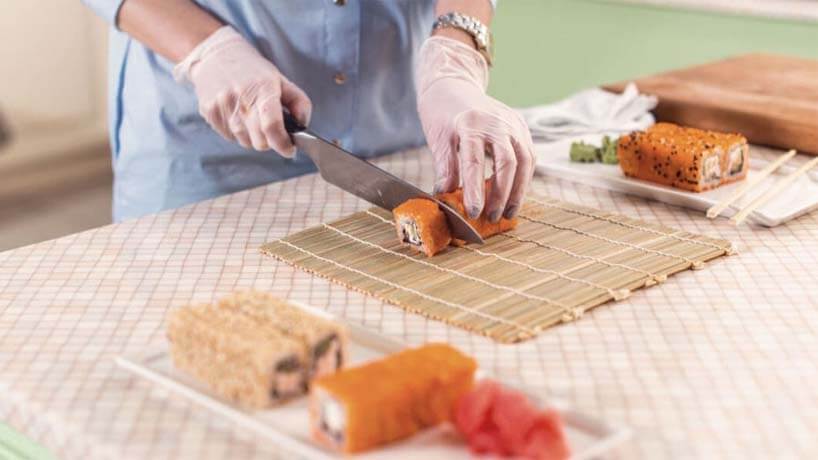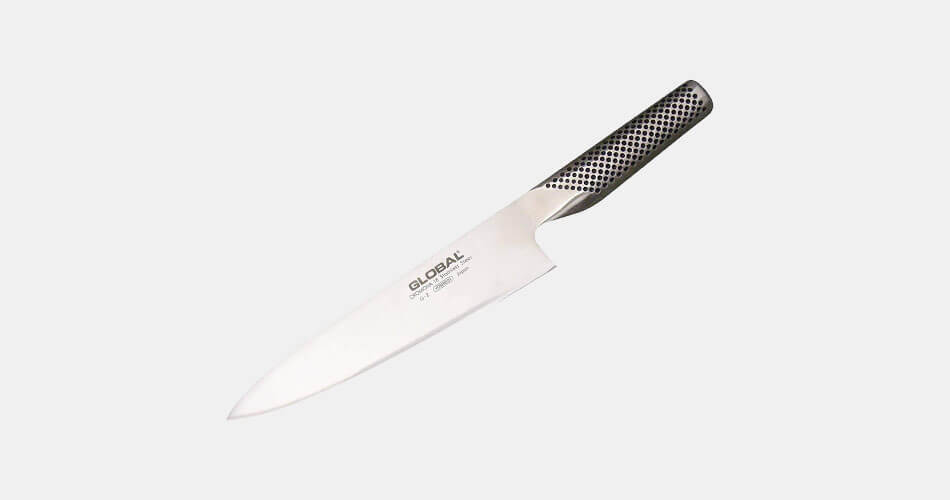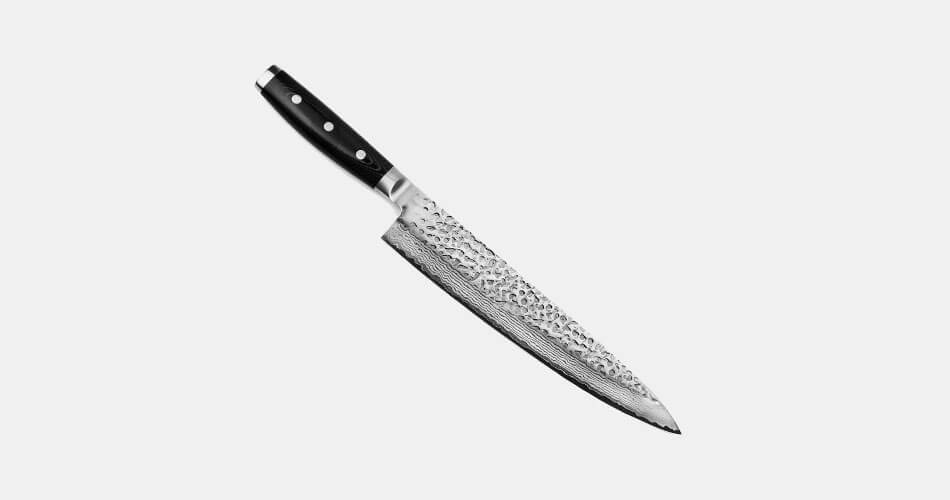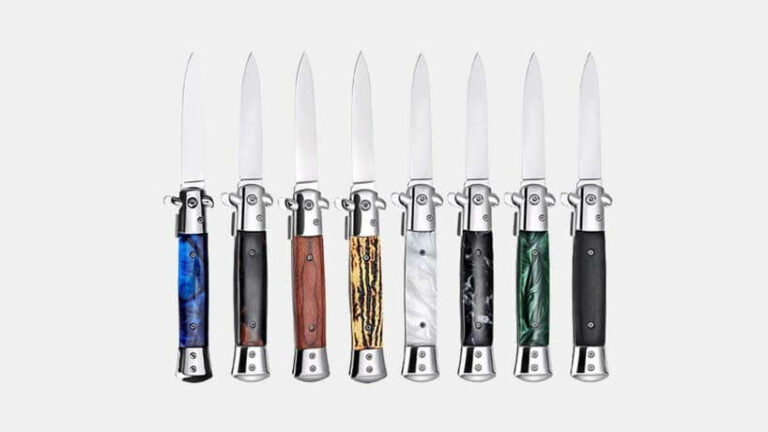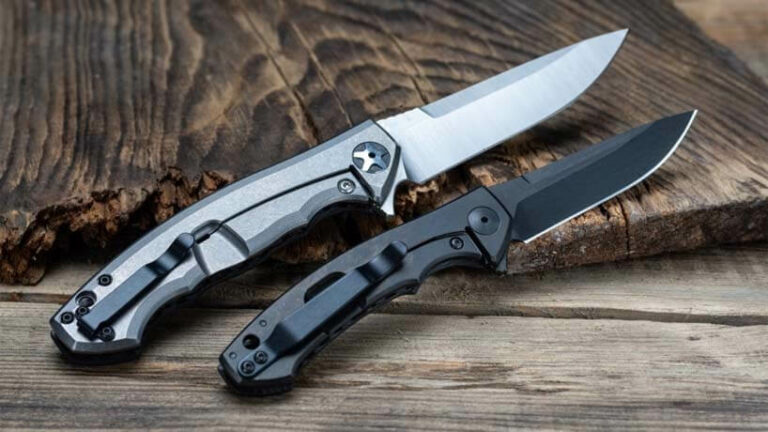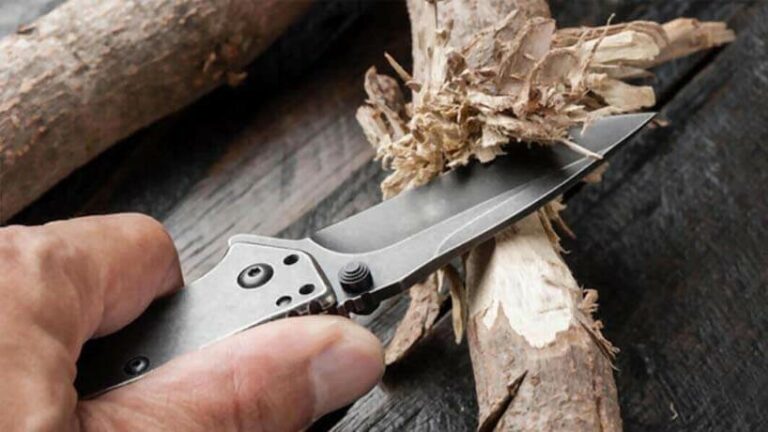Have you reached your full potential as a chef or enthusiast? If you’re serious about improving, then you’re going to need the right tools to help you reach your goals. We’ll look at some of our top picks for the best Japanese chef knife to help you reach your kitchen goals and become a better chef.
You’ll learn about what to look for in these exquisite knives and how to get excellent value for money. The wrong chef’s knife can make your time in the kitchen a lot slower and more difficult. By the end of the guide, you’ll be ready to choose the right knife that meets your needs and helps you get the best return on your effort – and fall in love with cooking!
Top 10 Best Japanese Chef Knife Reviews in 2023
We’ve taken a lot of time to go through countless options on the market. Choosing a quality chef knife isn’t as simple as picking the most expensive one or the one that looks the best. There are loads of subtleties that will make or break your experience with the knife.
Our reviews take the guesswork out of choosing a great knife by showing you its most unique and important features. Each review will be finished off with what we liked and didn’t like about each knife, giving you a more realistic idea of how they’ll perform in the real world.
Global Professional Chef Knife
This knife’s straight edge is disastrously sharp and is very useful in skilled hands. It beats beveled blades hands down in this respect. While the blade’s edge isn’t as sharp as some slightly more expensive chef knives, it holds its edge for a very long time. You won’t need to sharpen it frequently, making it perfect for everyday use.
You’ll need to take special care of this knife if you want it to show its real value. Make sure you hand wash it and always keep it dry. The handle has excellent grip and is relatively easy to clean, despite the grip holes gathering up a little dirt. Overall, it’s a high-quality knife that’s well-balanced and easy to use – one of our top value for money options in these best Japanese chef knives reviews.
- Excellent high-tech stainless steel construction
- Very well-balanced and has a weightless feel
- Lifetime warranty against build issues and defects
- The straight edge is incredibly sharp
- The grip holes in the handle can get food and grime stuck inside
- Needs careful maintenance to avoid rusting after a couple of months
Dalstrong’s Santoku Chef Knife
When you consider the price, this chef knife is a good bargain. Usually, handcrafted knives like this can cost quite a bit more. You’re getting all the benefits of a 60-day handcrafting period, at a very fair price. It’s a pretty thick blade at 12-14 degrees, making it excellent for quick chopping and slicing through thicker meat.
The blade is very sharp, but you need to be careful when handling it to avoid chipping and scuffing the edge. You should never put it in a dishwasher with other items and don’t use it for opening cans and boxes.
- Full-tang and riveted 3 times to enhance durability
- Very hard and sharp hand-crafted blade (3-step Honbazuke method)
- The handle is moisture, heat, and bacteria resistant
- The knife comes with a free knife sheath to protect it while it’s not in use
- Due to the 62+ Rockwell hardness, it’s quite a brittle and easy-to-chip blade if it’s not cared for properly
- It’s a 7” blade, so it’s a bit shorter than the standard 8” chef knife – it’s easier to handle but less versatile as a result
Shun Cutlery Premier Santoku Chef Knife
The design and aesthetics are astoundingly beautiful on this Shun knife. You get a water-ripple effect on the face of the blade (real ripples from the steel being folded) and a gorgeous handle. These looks combined with the high-level performance drive the higher price for this knife.
It’s a little more expensive than most of the knives on this list, but it well worth the money. You’ll have one of the tops picks for the best Japanese chef knife kitchens love to use. It’s very sharp and you’ll need a little skill to draw the most utility from this knife.
Beginners probably won’t find this knife as good an investment as an enthusiast or chef that’s got their techniques down. If you want to improve your cutting technique, here’s a fantastic read to get you started down the right path, or fine-tuning your current techniques.
- Beautiful rippling water effect on the blade
- Gorgeous Pakkawood handle with top-grade resistance to moisture and bacteria
- Excellent handling and workability for quick slicing and chopping
- Lightweight and well-suited to skilled users
- Expensive compared to some chef knives on this list
- Quite a brittle blade that needs lots of caring and maintenance
Enso Large Chef’s Knife
Here’s a larger chef knife that can take your work to the next level. It’ll take a little more skill to get the most out of it as the blade is 2” larger than the standard chef’s knife. It’s heavier than most 8” knives as well and this means you can cut through tough meat and vegetable with ease.
It’ll take a greater toll on your hands and forearm, but you’ll get through larger quantities easily. Despite the heavier weight, it’s a well-balanced knife that won’t feel too overweight. If you have a gentle frame, you might be better suited to getting a lighter 7” or 8” knife. It’s one of the best Japanese chef knives for handling heavier work, while still having the versatility of the chef knife.
- Not as brittle as you’d expect from a knife this sharp
- Very unique design with contrasting patterns on the blade
- Micarta handle is anti-crack and robust
- A longer 10” blade gives you good control and versatility but takes more skill to wield
- Longer blades aren’t suitable for all users (this is 10” vs standard 8”)
- Needs to be sharpened more frequently as the steel is slightly softer
Miyabi SG2 Chef’s Knife
This is arguably one of the best Japanese chef knives to have in your kitchen. Its professional-grade construction and careful formation make it a high-performing knife. It’s quite expensive and not an entry-level knife by any means. You’ll get top-quality results, but need the skills that go with it. It fits excellently into larger Miyabi sets that you can build up over time.
You’ll be able to have a well-rounded and versatile set of knives that can handle almost any kitchen’s requirements. So overall, while being a more significant investment, and a more specialized knife, you’ll get serious value for your money if you treat it right and have the skills to back it up!
- Smaller size that makes it excellent for light chopping and general kitchen work
- Stunning and durable Birchwood handle is unique
- Top of the line build with fantastic attention to detail with over 100 layers of steel
- Suitable for professional kitchens and commercial use
- Expensive compared to other knives on this list – though it is very high-end
- Might be a little small for some cutting work and people with big hands
Miyabi Fusion Chef Knife
Here’s a light and thin knife that’s easy to use. It’s great for use in a professional setting or kitchen and is exceptionally good at slicing and dicing vegetables, herbs, and light meats and fish. It mixes good old Western fashion grip and ergonomic design without giving up the benefits of an Asian blade.
You’ll pay less for this knife than you would for the equivalent German knife, so you’re getting good value for money considering the high-end attention to detail. You need to make sure that you have the right knife sharpening kit and techniques if you want to keep this blade in tip-top form.
Here’s a fantastic read to help you brush up on your sharpening techniques and knowledge! It’s a tempting pick for best-rated Japanese chef knife at this price point and has a lot to offer a skilled chef – both in its durability and performance.
- Authentic Japanese thin-style blade and non-beveled point
- Rockwell 60 rating that’s less brittle and more durable
- Mixed Western ergonomic design with traditional Japanese design and Katana edge
- Perfect handle for larger hands and use in a professional kitchen
- A little thin and light to handle cutting through thick and tough meat
- The handle joins to the blade in a pull-away fashion that might not be super-durable in the long run
Yoshihiro Hammered Gyuto Chef’s Knife
The first thing that will stand out when you get your hands on this knife is its looks. It’s one of the best looking knives I’ve used. The mixture of the kanji characters, the hammered blade-side, and the Damascus finish, give you a knife that looks traditional and premium at the same time.
You’ll be enthralled by the balance of the knife. It was way more comfortable than I expected it to be, especially considering the larger 9.5” size. If you’re willing to invest in a quality knife set, Yoshihiro has an excellent collection.
It’ll cost you, but you’ll come out with one of the best Japanese chef knife sets on the market. If you want to know more about what types of knives are essential – and how to use them – here’s an awesome article to read. Gordon Ramsay goes over the knives you should have in your kitchen.
- Excellent customer service and craftsmanship
- Perfectly balanced blade with a large 9.5” size
- Utterly gorgeous with a very rugged handle that’ll last a long time
- Fits into the larger Yoshihiro set for a complete performance
- Only comes sharpened on one side of the blade, so you’ll need to touch up the other side on a whetstone
- The knife might be a bit too large and heavy for finely slicing fruit and veggies
Kasumi 88020 Chef’s Knife
Make sure your sharpening tools and techniques are up to scratch if you plan on getting this knife. It can get very sharp, but you need to have the skill to get it there. It’s a great knife for general kitchen use and is a little on the light side – so it’s not suited to heavier slicing and chopping.
You’re getting the versatility of an 8” knife and the usability of a lighter 6” or 7” knife. The finish on both the handle and the blade could be more refined. This isn’t much of an issue for me, but it could be for you if you need a knife that looks good. It’s a fantastic best Japanese chef knife for the money and gives you performance and durability that’s well worth the investment.
- The excellent price point for a VG-10 knife
- The rounded handle fits in your hand very well
- Extremely sharp edge makes up for the lack of weight
- All the versatility on an 8” chef knife
- The finish of the handle and blade isn’t as good as some similarly priced knives
- Larger hands might struggle to find a good grip on the handle
Shun Cutlery Classic Chef’s Knife Set
If you’re looking for great value for your money, this set needs your attention. You’re getting two knives ( an 8” chef knife and a 3.5” paring knife) that are super-sharp, with ergonomic designs and stunning looks. It’s a great combination to have in your kitchen. The paring knives are perfect for getting thin and fine slices of fruits, vegetables, and herbs.
On the other hand, you’ll have the 8” chef knife to handle the larger cuts and slicing meat. All you’ll need to complete your entry-level set is a weightier cleaver to handle thick meat and bones. What caught my eyes the most about the chef’s knife is the hollow ground along the edge.
While this makes the blade slightly more fragile, the blade becomes more apt at slicing precisely. This feature also prevents food from sticking to the blade. The Damascus cladding on both these blades consists of 34 micro-layers of VG Max stainless steel.
While this makes sure the blades are very sharp, they require stropping or regularly honing to keep that sharpness. So don’t skip out on regular maintenance. These two excellent knives come in a very giftable box. You’re getting better quality than you’re paying for, making this one of the better inexpensive Japanese chef knife sets.
- You get 2 knives for almost the price of one
- Gorgeous design and dark rounded ebony Pakkawood handle
- 5” paring knife is exquisitely sharp and ergonomically designed
- Both blades are double-beveled and have sturdy tips for extra versatility
- More aimed at entry-level chefs and enthusiasts
- Not much clearance off the cutting board for your knuckles (mainly with the smaller paring knife)
Yoshihiro Inox Sujihiki Japanese Chef Knife
While its appearance is unique and seemingly not as sturdy as some chef knives, this 9.5” thin blade is very capable. You’ll be able to carve up meat and fish just as easily as you’ll handle vegetables and fruit. You’re getting the almost unparalleled quality of a Yoshihiro chef knife at this price point. The value for money is hard to ignore when you consider how versatile and capable this knife is.
In terms of aesthetics, it’s not the finest knife on the market, but it fills that gap by being an excellent and reliable performer for budding and professional chefs alike. It’s a solid choice and one of the top best Japanese chef knives to have in your collection!
- The thinner blade helps better preserve the freshness and integrity of fruits, meats, and vegetables
- Extremely versatile blade with the ability to carve like much heavier Japanese chef knives
- Excellent value for money for a high-quality Yoshihiro knife
- Your knuckles get good clearance off the cutting board
- Might struggle with very thick meat that’s bony
- The handle is a little short if you have large hands
Why Choose a Japanese Chef’s Knife Over other Types?
Generally speaking, Japanese knives use harder steel than their Western and European counterparts. German knives typically have a hardness rating between HRC 52 – HRC 56, whereas Japanese blades HRC 58 and up. You’re able to sharpen them to a finer edge and to a level that’s hard to reach with many German knives.
This also means that they are more brittle and are prone to chipping. German knives will need to be sharpened more often, and won’t hold their edge as long. Best Japanese chef knives also tend to be quite a bit lighter than most German knives. This lighter build makes them better at chopping, slicing, dicing, and mincing, while German knives are better suited to cutting through thicker meat and bones.
German knives don’t use a wide range of steel and manufacturing methods for their knives. They mostly follow the same processes and use similar types of steel. Japanese knives, on the other hand, use varied steels depending on the type of blade and the finish they’re going for.
You’ll get excellent versatility from Japanese knives – but it’s harder to choose the right one. Japanese knives usually use double-beveled edges with a sharp point to the knife. This helps them achieve culinary effects that are unique to Japanese foods.
How to Find the Right Chef Knife for You
There are a couple of different aspects you need to consider when choosing a chef knife that’s right for you. The first thing to consider is the handle and the size of your hands. There’s nothing worse than using a poorly balanced knife that’s not comfortable in your hands.
You’ll end up straining your wrist and having a terrible time prepping your meals. I prefer D-shaped handles. The one you choose needs to be guided by what you’re comfortable with and what helps you work faster and more efficiently. The weight and size of the blade are also important.
You can’t go wrong with the standard 8” chef knife – but this doesn’t take your unique needs into account. If you’re more interested in carving meats and cutting through some bones, you should probably go with a larger and heavier 9.5” or 10” chef knife.
If you’re doing light kitchen work like chopping and dicing, then a smaller 7” chef knife might be better for you. The final thing you should consider is how easy the knife is to clean, maintain, and sharpen. This is especially important if you’re a working professional, as food safety and hygiene are essential.
How to Maintain and Care for a Japanese Chef Knife
Japanese knives need even more care and attention than most German and Western knives – but it’ll reward you for your efforts. Here are some tips that you can follow to make sure you get the most value from your knife and keep it in tip-top shape for longer:
Wash and dry the knife after every use: It’s essential if you want to protect the knife from rust and bacteria. Make sure you clean the handle thoroughly and don’t put the knife in the dishwasher. Dishwasher detergent can be harmful to the knife and the handle, so always wash it by hand.
Don’t pry and wedge with the knife: This means that you shouldn’t be using the knife for anything other than its intended uses. Don’t open tin cans, avoid lateral movements, and try not to pry anything open. You should avoid cutting through bones and other very hard objects. Use a cleaver or relevant tool for those jobs.
Use the right cutting board: Only use plastic or wooden cutting boards. Don’t skimp and buy a cheap cutting board that’ll ruin your expensive premium knife.
Be careful who you let use your knife: Make sure that when you have friends or family over to your house that your knives are either out of sight. You should only let experienced users handle your knives, and that they take the correct maintenance and care steps.
If you follow all of these steps and take care of your knife, it will perform astoundingly. If you’re a beginner or budding enthusiast, make sure you take some time to study how these exquisite knives are crafted and how you should care for them.
Most of the mistakes I see people making with Japanese and other premium knives are a product of ignorance. Taking the time to learn will save you lots of money and frustration in the long run.
Knives You Should Have That Complement a Chef Knife
There are quite a few types of knives to choose from when you’re looking for a complete knife set for your kitchen. Naturally, some knives are more useful than others, and budgets are often limited too. There a few knives that are essential for your kitchen and would complement your chef knife well.
The first knife (other than the best Japanese chef knives) to get is a paring knife. They’re generally 2” – 4” long. You can think of them as smaller versions of the chef knife. They’re perfect for kitchen tasks where bigger knives are a hassle to use, such as peeling onions and fruits, cutting up veggies, and chopping up herbs.
They’re easy, light, and comfortable to use and will save you time and effort compared to using a larger knife. The second essential kitchen knife to have is a serrated blade. Yes, you read that right! Serrated blades aren’t just there for cutting slices of bread. They’re excellent at cutting through anything that has different textures on the outside and inside of the food.
Crusted bread is the most common, but you can use them for cutting through tomatoes and even meat. Finally, you should consider getting a cleaver in your kitchen. This will help to preserve your chef knife as it won’t need to cut through bones. Cleavers can make quick work of thick pieces of meat and bones. They thrive where most other knives struggle.
How to Sharpen a Premium Chef Knife
Using a sharp knife in your kitchen is 100% more efficient and far quicker. You can make a real mess of your food if you’re using blunt knives. The secret is to make sure you sharpen the knife before and after you use it. I like to use the handheld sharpening bar with the protective butt for your fingers. They’re easy to hold and are safe to use.
Keep the knife and the sharpening block at 45-degrees to each other and make sure you use the whole length of the whetstone. You want to slide the whole knife-edge in one stroke. Move the blade away from your body and don’t sharpen it into the knife edge. Repeat this process on both sides of the knife, taking care to keep your fingers clear of the path of the knife and below the butt in case the knife slips.
Frequently Asked Questions (FAQs)
Q: What Is a Japanese Chef Knife?
A: A Japanese chef knife is a bit different from your regular kitchen knife. There are three common types of Japanese knives: the ‘gyuto’ (chef’s knife), ‘santoku’ (general purpose), and ‘bunko’ (thinner, general-purpose).
The main difference between the aforementioned Japanese knives is the length of the blade. The ‘gyuto knife’ can be 8-12 inches long, while the ‘santoku knife’ and ‘bunko’ can be 5-8 inches long. The Japanese chef knife is meant to do more cutting preparations like cutting raw meat or fish and precision cutting of multiple ingredients.
Q: What Can Be the Difference Between Japanese-Style and Western-Style Knives?
A: If you compare a Western-style knife and a Japanese-style knife, it will boil down to how the knives are forged. Looking closely, a Japanese-style knife resembles that of a katana. Not only it has the appearance, but the blade construction also borrows the forging techniques from katana-making.
On the other hand, Western-style knives may vary. Japanese-style knives may be more prone to rusting, but the edge retention and sharpness are better.
Q: How Do You Maintain the Sharpness of Japanese Knives?
A: Over the years, even the best blade can lose its edge when used often. It will gradually become dull and misaligned. Using conventional methods of sharpening a Japanese chef knife may not work since it is similar to a katana, both in appearance and the forging process.
The best method that can probably regain a Japanese knife’s edge is through sharpening with a whetstone. However, it needs a proper procedure for sharpening, and it is recommended to do it minimally but often to keep the blade fine.
Final Thoughts
That’s it for our guide. We hope you’ve found clear and concise solutions to your questions. You’ve started on the right path to getting the results you want to see and becoming the chef you want to be. I encourage you to take the step and order the knife that grabbed your attention and meets your needs. Soon you’ll have the best Japanese chef knife in your hands and you’ll be on your way to becoming the best chef you can be! Good luck!

